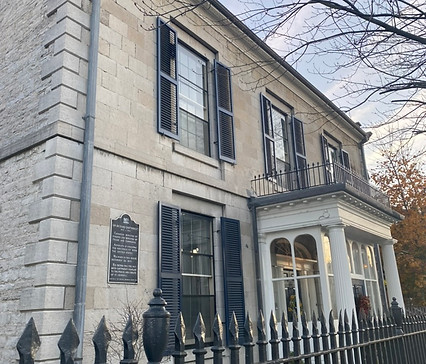The Limestone Legacy

Plaque commemorating Cartwright House. Photo taken by Sam Nicholls, 2020.

Cartwright House. Photo taken by Sam Nicholls, 2020.
If there is one other thing that the City of Kingston is known for, it would be its distinct limestone architecture. Nicknamed the “Limestone city,” Kingston is decorated with Limestone buildings, ranging from military fortifications to office spaces and commercial buildings, and especially homes. Several of these buildings are protected under the Ontario Heritage Act, or other heritage preservation policies at the municipal, provincial and even national level. Many of these spaces are occupied by middle class families , perhaps many unaware of the limestone architecture's deeply rooted colonial narrative. Derek Alderman considers the idea that “places exert their own subtle influence over society, broadcasting what is ‘known’ to be important and trivial, honourable and corrupt, beautiful and repulsive.”[1] Through the preservation of Kingston’s limestone architecture, the city exerts its own ideas of what is worth preserving and what is not. The preservation of places that have distinct colonial presence influences society to believe that these buildings should be valued more so than alternative structures and buildings in the area.
The Cartwright House, located on 223 King Street East in Kingston is an example of a well-preserved limestone house, protected under the Ontario Heritage Act. Former home of the Sir Richard Cartwright, the Canadian minister of Finance and Minister of Trade and Commerce in the late nineteenth century, this house perfectly exemplifies the types of homes that are chosen to be commemorated and preserved throughout the city. The Cartwright family is notable for their engagement in the politics and the local economy, similar involvement to that of Sir John A Macdonald. By preserving and memorializing this home, the provincial government under the Ontario Heritage Act and the City of Kingston influence a narrative of what is ‘worthy’ of being preserved. They are setting an example of the types of homes and histories that are integral to Kingston’s built heritage, and therefore producing histories that privilege settler colonial narratives and experiences over other, marginalized communities.
Although buildings such as the Cartwright house are not necessarily monuments, they nonetheless “communicate between actual communities of people and abstract machinery of the nation-state,” as Kirk Savage suggests.[2] Beyond the Cartwright house, other homes such as the ones featured on this page demonstrate the presence of a community – a community of settlers whose narratives are continuously upheld by policies and Acts that preserve their built heritage. Governmental policies that explicitly acknowledging the importance of Kingston’s built, physical, colonial landscape demonstrates how commemorative practices directly seek to perpetuate settler colonial memory. The bureaucratic process by which heritage homes and buildings are designated, such as the City of Kingston Commemoration Policy, distinctly honours the values of those in places of political and economic power, therefore allowing built heritage to reflect rather narrow narratives.
Works Cited
[1] Derek Alderman, Civil Rights Memorials and the Geography of Memory. (Chicago: Center for American Places at the Columbia College Chicago, 2008), vii.
[2] Kirk Savage, “Introduction,” Standing Soldiers, Kneeling Slaves: Race, War and Monument in Nineteenth Century America, 2nd edition, (New Jersey: Princeton University Press, 2018), 6.




Commemorative plaque on a limestone house in Kingston, Ontario.
Photo taken by Sam Nicholls, 2020.
Commemorative plaque on a limestone house in Kingston, Ontario.
Photo taken by Sam Nicholls, 2020.
Commemorative plaque on a designated heritage house in Kingston, Ontario.
Photo taken by Sam Nicholls, 2020.